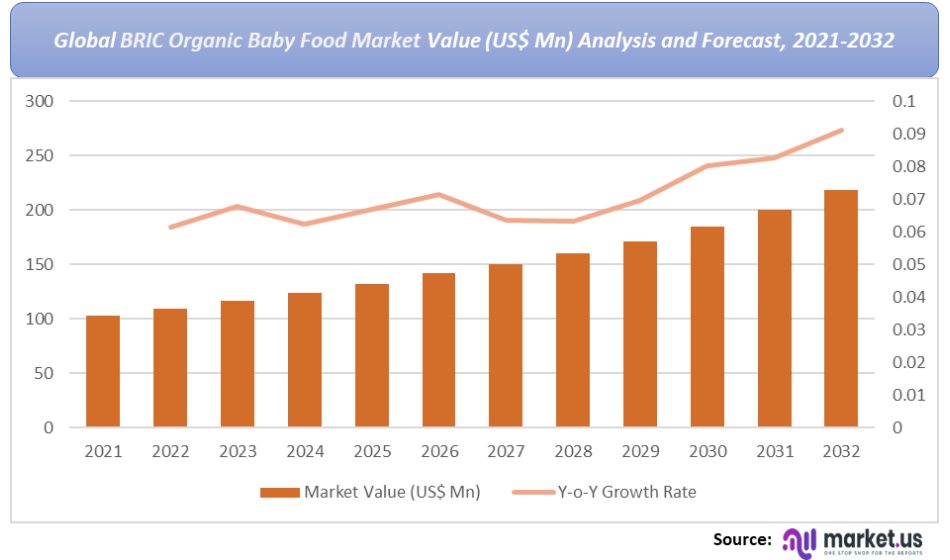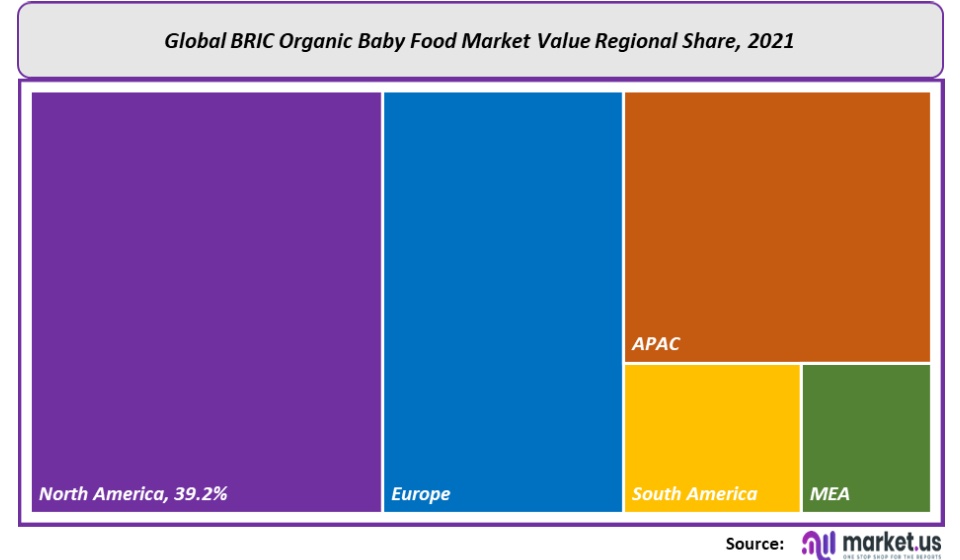Global BRIC Organic Baby Food Market By Product (Milk Formula Organic Baby Food, Ready-to-Feed Organic Baby Food, Dried Organic Baby Food, Prepared Organic Baby Food), By Distribution Channel (Specialty Outlets, Supermarkets, Online Platforms, Chemists/Pharmacies/Drugstores), By Region, and Key Companies - Industry Segment Outlook, Market Assessment, Competition Scenario, Trends and Forecast 2022-2032
- Published date: Jan 2022
- Report ID: 74670
- Number of Pages: 373
- Format:
- keyboard_arrow_up
Organic baby food meets the strict regulations set by USDA’s National Organic Program. This implies that the raw materials used in producing this food, such as vegetables and fruits, have not been sprayed or exposed to pesticides, and animal meat has been supplemented with antibiotics. Moreover, organic baby food does not contain artificial flavors, preservatives, or colors.
Organic baby food reduces exposure to pesticides and other harmful contaminants in infants. Studies have suggested that exposure to pesticides and other conventional foods can make babies more vulnerable to various health problems during the neurodevelopment stage. Increasing concerns among parents regarding the side effects of chemical ingredients in baby foods have been a source of encouragement for consumers to adopt organic alternatives.
An increased focus on clean label trends is expected to bolster the demand for plant-based ingredients. As per a study by Future Market Insights (FMI), the sales of organic baby foods are set to surge immensely in the coming years. This market is expected to reflect a double-digit CAGR through 2021 and beyond.

Detailed Segmentation for BRIC Organic Baby Food Market–
Based on Product Type:
- Milk Formula Organic Baby Food
- Ready-to-Feed Organic Baby Food
- Dried Organic Baby Food
- Prepared Organic Baby Food
- Others Product Types
Based on Distribution Channel:
- Specialty Outlets
- Supermarkets
- Online Platforms
- Chemists/Pharmacies/Drugstores
- Others
Based on Region:
- North America
- Europe
- Asia-Pacific
- South America
- Middle East & Africa

Market Dynamics Global for BRIC Organic Baby Food Market –
Drivers for BRIC Organic Baby Food Market:
Organic baby foods comply with the strict regulations set by the USDA National Organic Program. This implies that raw materials used in producing organic foods such as vegetables and fruits have not been sprayed or exposed to pesticides, and animal meat has been supplemented with antibiotics. In addition, organic baby food contains no artificial flavors, preservatives, and colors.
Organic baby foods reduce exposure to pesticides and other harmful contaminants in infants. Studies have suggested that exposure to pesticides and the consumption of other conventional foods can make babies more vulnerable to various health problems during the neurodevelopment stage.
Restraint BRIC Organic Baby Food Market:
A lack of awareness concerning organic foods, particularly in rural areas, could negatively impact sales prospects. In addition, organic farmers and food producers in BRICS countries, India and South Africa in particular, have faced challenges in terms of certification standards as they are complicated and in many cases, not strictly enforced. This remains a challenge for baby food manufacturers and hampered raw materials supplies and distribution, particularly in exports.
Opportunity BRIC Organic Baby Food Market:
Organic baby cereal manufacturers are now focusing on formulations with nutrition-based ingredients, including rice, wheat, oatmeal, etc., to meet the high nutrition requirements recommended for early-stage infant care. Organic baby food is still at a nascent stage. However, market growth is expected to be strong with the emergence of numerous startup businesses.
India has surpassed China in birth rates, accounting for 17.3 births per 1000 individuals in 2021. This is a key factor that would result in this country being a potentially lucrative market for manufacturers through 2031.
Trends BRIC Organic Baby Food Market:
Product innovations by manufacturers are an observable trend in the BRIC organic baby food market, expected to lead to a spike in market growth. For example, in May 2019, Nestlé launched an organic product within its Ceregrow brand of cereals for children over 12 months of age, made from 100% organic ragi, wheat, milk, and rice. This product is made at the company’s Samalkha factory in Haryana, India, using locally grown ingredients.
Manufacturers’ practical and attractive packaging strategies by manufacturers to generate greater interest among consumers is another major trend in this market. Various players are adopting various packaging techniques to increase their respective consumer bases. Moreover, the demand for and use of sustainable and eco-friendly packaging by major players is also expected to boost economic growth prospects for the BRIC organic baby food market.

Competitive Landscape –
- Nestle S.A, H.J
- Heinz Company
- Groupe Danone
- British Biologicals
- Abbott Laboratories
- Bellamy’s Australia Limited
- Campbell Soup Company
- Otsuka Holdings Co. Ltd.
Recent Development:
- In 2020, MegaFood, a leading manufacturer of premium supplements that combines minerals and vitamins with real food, launched two new Baby & Me 2 products, including Postnatal Multi and Prenatal DHA & Choline.
- In March 2021, GoBiotix launched new pre and postnatal multivitamin products for mother and child requirements and included vitamins such as vitamins E, C, A, D2, B6, K, B12, and Iodine, which help in enhancing breast milk.
- In October 2020, Arcadia Consumer Healthcare Inc. announced the acquisition of Naturelo, a company engaged in vitamin and mineral supplements. The expansion will help Arcadia to expand into the pre and postnatal products market.
For the BRIC Organic Baby Food Market research study, the following years have been considered to estimate the market size:
Attribute Report Details Historical Years
2016-2020
Base Year
2021
Estimated Year
2022
Short Term Projection Year
2028
Projected Year
2023
Long Term Projection Year
2032
Report Coverage
Competitive Landscape, Revenue analysis, Company Share Analysis, Manufacturers Analysis, Volume by Manufacturers, Key Segments, Key company analysis, Market Trends, Distribution Channel, Market Dynamics, COVID-19 Impact Analysis, strategy for existing players to grab maximum market share, and more.
Regional Scope
North America, Europe, Asia-Pacific, South America, Middle East & Africa
Country Scope
United States, Canada and Mexico, Germany, France, UK, Russia and Italy, China, Japan, Korea, India and Southeast Asia, Brazil, Argentina, Colombia etc.Saudi Arabia, UAE, Egypt, Nigeria and South Africa
![BRIC Organic Baby Food Market BRIC Organic Baby Food Market]() BRIC Organic Baby Food MarketPublished date: Jan 2022add_shopping_cartBuy Now get_appDownload Sample
BRIC Organic Baby Food MarketPublished date: Jan 2022add_shopping_cartBuy Now get_appDownload Sample - Nestlé S.A Company Profile
- Heinz Company
- Groupe Danone
- British Biologicals
- Abbott Laboratories
- Bellamy’s Australia Limited
- Campbell Soup Company Profile
- Otsuka Holdings Co. Ltd.
- settingsSettings
Our Clients
|
Single User
$5,999
$2,999
USD / per unit
save 50% |
Multi User
$7,999
$3,499
USD / per unit
save 55% |
Corporate User
$12,999
$4,499
USD / per unit
save 65% | |
|---|---|---|---|
| e-Access | |||
| Data Set (Excel) | |||
| Company Profile Library Access | |||
| Interactive Dashboard | |||
| Free Custumization | No | up to 10 hrs work | up to 30 hrs work |
| Accessibility | 1 User | 2-5 User | Unlimited |
| Analyst Support | up to 20 hrs | up to 40 hrs | up to 50 hrs |
| Benefit | Up to 20% off on next purchase | Up to 25% off on next purchase | Up to 30% off on next purchase |
| Buy Now ($ 2,999) | Buy Now ($ 3,499) | Buy Now ($ 4,499) |









